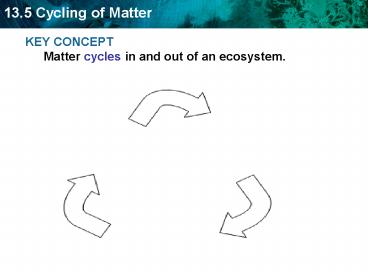KEY CONCEPT Matter cycles in and out of an ecosystem. - PowerPoint PPT Presentation
Title:
KEY CONCEPT Matter cycles in and out of an ecosystem.
Description:
KEY CONCEPT Matter cycles in and out of an ecosystem. Elements essential for life also cycle through ecosystems. A biogeochemical cycle is the movement of a ... – PowerPoint PPT presentation
Number of Views:192
Avg rating:3.0/5.0
Title: KEY CONCEPT Matter cycles in and out of an ecosystem.
1
KEY CONCEPT Matter cycles in and out of an
ecosystem.
2
Elements essential for life also cycle through
ecosystems.
- A biogeochemical cycle is the movement of a
particular chemical through the biological and
geological parts of an ecosystem.
3
- The hydrologic, or water cycle is the circular
pathway of water on Earth from the atmosphere, to
the surface, below ground, and back
- Evaporation
- Cloud formation
- Precipitation
- Transpiration (loss of H2O from plants)
- Condensation
- Runoff
4
Hydrologic Cycle
- Precipitation rain or snow falls to ground
- Water seeps into ground, ponds, streams, swamps,
wetlands, lakes, etc. - Empty into oceans
- Evaporation water reenters atmosphere
- Transpiration water vapor released by plants
- Condensation water vapor in atmosphere creates
clouds
5
- Oxygen cycles indirectly through an ecosystem by
the cycling of other nutrients.
6
Oxygen Cycle
- Plants release oxygen as waste during
photosynthesis - Animals breathe in oxygen
- Animals release carbon dioxide during cellular
respiration - Plants take in carbon dioxide
7
- Carbon is the building block of life.
- The carbon cycle moves carbon from the
atmosphere, through the food web, and returns to
the atmosphere.
Carbon Dioxide in air
Burning of Fossil fuels
Photo- synthesis
Carbon Dissolved In water
respiration
decomposition
8
Carbon Cycle
- Plants use energy from the sun to convert carbon
dioxide into sugar that become part of the
plants structure - Moves to animals as they eat plants and as one
organism eats another - Carbon is returned to the atmosphere by
- 1. respiration
- 2. decomposition of dead organisms
- 3. Burning of fossil fuels and wood
- 4. Emissions from factories/cars
- 5. Methane emission from wetlands/landfills/livest
ock
9
- The nitrogen cycle mostly takes place underground.
10
Nitrogen Cycle
- Bacteria turns gaseous nitrogen into ammonia
- Ammonia released into the soil is transformed
into ammonium by materials in the soil - Nitrifying bacteria change the ammonium into
nitrate - Nitrate is taken up by plants
- Plants convert the nitrate into amino acids and
proteins - Nitrogen moves through the food web as animals
eat plants and/or other animals - Nitrogen returned to soil as decomposers break
down animal excretions or dead animals - Denitrifying bacteria use nitrate as an oxygen
source, releasing nitrogen gas into the
atmosphere as a waste product
11
- The phosphorus cycle takes place at and below
ground level.
- Phosphate is released by the weathering of rocks.
- Phosphorus moves through the food web and returns
to the soil duringdecomposition.
- Phosphorus leaches into groundwater from
the soil and is locked in sediments. - Both mining and agriculture add phosphorus
into the environment.































